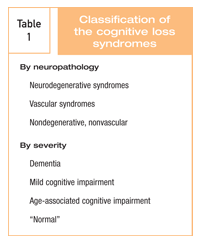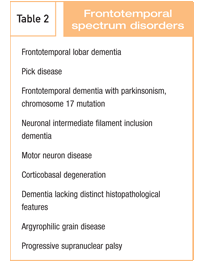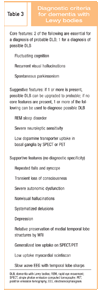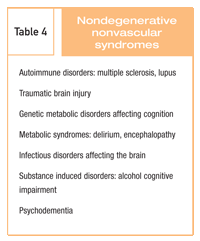The Dementias: Neuropsychiatric Syndromes of the 21st Century
In the new century, the dementias will probably become 1 of the 2 or 3 dominant behavioral health problems in the United States. This article provides an overview of the major clinical features of these cognitive loss syndromes and emphasizes the perspective of the practicing psychiatrist.
Psychiatric Times - Category 1 Credit
You must keep your own records of this activity. Copy this information and include it in your continuing education file for reporting purposes.
CME LLC is accredited by the Accreditation Council for Continuing Medical Education to provide continuing medical education for physicians.
CME LLC designates this educational activity for a maximum of 1.5 AMA PRA Category 1 Credits™. Physicians should only claim credit commensurate with the extent of their participation in the activity.
CME LLC is approved by the California Board of Registered Nursing, Provider No. CEP12748, and designates this educational activity for 1.5 contact hours for nurses.
The American Nurses Credentialing Center (ANCC) accepts AMA PRA Category 1 Credits™ toward recertification requirements.
The American Academy of Physician Assistants (AAPA) accepts AMA PRA Category 1 Credits™ from organizations accredited by the ACCME.
Sponsored by CME LLC for 1.5 Category 1 credits.
Original release date 10/08. Approved for CME credit through April 2009.
Educational Objectives
After reading this article, you will be familiar with:
• The classifications of cognitive loss syndromes.
• The clinical features of these syndromes.
• The neurobiology of these disorders.
• Current treatment approaches.
Who will benefit from reading this article?
Psychiatrists, neurologists, primary care physicians, geriatricians, nurse practitioners, and other health care professionals. Continuing medical education credit is available for most specialists. To determine whether this article meets the continuing education requirements of your specialty, please contact your state licensing board.
In the new century, the dementias will probably become 1 of the 2 or 3 dominant behavioral health problems in the United States. This article provides an overview of the major clinical features of these cognitive loss syndromes and emphasizes the perspective of the practicing psychiatrist. In addition, some of what is known about the neurobiology of these disorders is summarized and a brief review of current treatment approaches is provided.
The challenge for psychiatry
The sheer numbers of persons with cognitive loss disorders, as well as their attendant behavioral implications, will require the attention of practicing psychiatrists:
• Alzheimer disease (AD), 6 million.
• Alzheimer spectrum, milder syndromes, 6 million.
• Lewy body syndromes, 1 million.
• Vascular syndromes, 1 million.
• Frontotemporal dementias, 0.5 million.
Indeed, current prevalence estimates of this burgeoning epidemic are thought to be on the low end. The number of people affected by these syndromes is expected to rise steadily as diagnostic processes improve and the population ages.
All of the syndromes share certain features. They are all age-related. Rarely do any of them present before age 50. They present clinically with the insidious onset of behavioral change, although some of them demonstrate secondary findings in neuromotor and movement domains. Their clinical features are dominated by cognitive loss, but all of them have signature changes in other behavioral domains as well. They progress relentlessly. None of them have laboratory or imaging diagnostic tests that can replace the judgment of a skilled behavioral clinician. In addition, all of them, or at least most of them, have treatments that may confer modest but significant benefit to those with the disorders and their families.
Classification of the cognitive loss syndromes
Cognitive loss disorders can be classified along 2 axes, according to severity and neuropathology (Table 1). Classification of these cognitive loss disorders by severity is based on expert clinical-medical opinion that follows current diagnostic criteria. The judgment of an experienced clinician that a cognitive loss syndrome is present and that it has (or has not) generated psychosocial or vocational impairment is the gold standard. Neuropsychological testing, imaging, and ancillary medical testing confirm the diagnosis.
Dementia is a generic term for cognitive loss syndromes of such severity that they produce psychosocial or vocational functional impairment.1,2 Any of the neuropathologies listed in Table 1 can produce dementia, once the disease has advanced sufficiently.
Mild cognitive impairment (MCI) is an evolving concept. It signifies a cognitive loss syndrome that is milder than dementia and does not (yet) cause functional impairment.3 MCI may affect 1 or more cognitive domains. When 1 of the domains affected is memory, the syndrome is called MCI amnestic type. When nonmemory domains are affected, it is called MCI nonamnestic type. The determination that a cognitive domain is affected is based on a comparison of the patient’s neuropsychological test performance against age- and education-adjusted norms.
A diagnosis of MCI is grounded more strongly in neuropsychological test performance than is the dementia syndrome, where diagnosis remains more strongly in the realm of medical judgment. These issues can create problems in the clinical application of the MCI diagnosis because no single neuropsychological test invokes or determines a cognitive domain. In addition, the age- and education-adjusted norms for neuropsychological testing in older adults may have been skewed by the inclusion of MCI-like syndromes among the populations studied.
Age-associated cognitive impairment and related terms refer to cognitive loss syndromes that are milder than MCI. In age-associated cognitive impairment, the patient complains of cognitive loss, usually in 1 of the memory domains, but neuropsychological testing fails to show impairment compared with adjusted performance norms. The boundary between patients with age-associated cognitive impairment and “normal” controls is still unclear.
Normality is a more problematic clinical concept with regard to cognitive function than one might think. Sometimes, in cognitive research protocols where we seek “normals,” we are in an analogous situation to the ancient Archimedes, who spent his life searching for an honest man and was never quite sure that he had found one.
The core problem with defining normal cognition is that we presently accept a pattern of steady and robust cognitive deterioration across the life span as normal aging. This may be a form of cognitive prejudice. Neuropsychological test performance is adjusted against population norms that may have included many persons with MCI and age-associated cognitive impairment–type syndromes. We presently diagnose normal cognition when a reliable informant states that the patient has not shown evidence of cognitive loss-a somewhat vague and unsatisfying concept of normality.
It could be said that in our evolving understanding of neuropathologies of the dementias, these disorders remain poised part way between neurology and psychiatry. In neurology, we expect objective neuropathological confirmation of clinical syndromes. In psychiatry, we find subtle neuropathological changes in the major psychosyndromes, but we do not fully understand them. The neuropathological features of the degenerative disorders, especially AD, are weakly correlated with clinical symptoms according to severity, and the great majority of persons older than 65 have some of these neuropathological features.
Some persons have dementia without any characteristic neuropathological findings. There is a great deal of overlap across the pathological boundaries of the disorders. Almost all patients with AD also have vascular pathology. Furthermore, almost all patients with dementia with Lewy bodies have AD changes in their brain as well. Some of the key terms, such as neurodegenerative, come from an earlier era, and are likely to be replaced by more specific molecular-genetic language soon.
Alzheimer disease
The neurodegenerative syndromes are cognitive loss syndromes of later life characterized by slowly progressive clinical change, aggregation of abnormally metabolized chaperone proteins in brain and neurons, the accretion of abnormal protein-aceous material in intercellular spaces, and cell death by apoptosis. The archetypal neurodegenerative dementia is AD-the dementia with clinical features that defines a clinical model against which all other cognitive loss syndromes are measured. The National Institute of Neurological and Communicative Disorders and Stroke criteria for AD are:
• Dementia present (a progressive cognitive loss syndrome of sufficient severity to cause impairment of social or vocational function).
• Onset between the ages of 40 and 90 years.
• Deficits in 2 or more cognitive areas.
• Progression of deficits for more than 6 months.
• Consciousness undisturbed.
• Absence of a better medical explanation for the syndrome.

In AD, memory failure almost always is the first cognitive domain affected; personality features and neuromotor functions are generally retained until later in the disease course. A variety of noncognitive neuropsychiatric features inevitably accompany the syndrome; these include apathy, agitation, atypical psychotic features, depression-like syndromes, and stereotypical behavioral disorders.
The neuropathological mechanisms that underlie AD are multiple and include the accumulation of abnormally phosphorylated t proteins within neurons (tangles), the accumulation of 42 amino acid amyloid fragments within the neuropil (plaques), vasculopathic changes within blood vessels, small strokes, and neuronal death.
Perhaps the starkest evidence that genetic factors play a role in AD came from recent studies that showed an association between point mutations in any of 3 gene loci (amyloid precursor protein gene, presenilin 1, presenilin 2) and autosomal dominant inherited AD, which was clinically and pathologically identical to nongenetic AD, except for a younger age at onset. For late-onset AD, the most common form of the disorder, it has proved more difficult to find the genetic loci. There is a risk locus at the apolipoprotein gene on chromosome 19. Secondary genes are known to exist as well, but it has proved difficult to find these outside delimited populations. Total genome screen studies, even of large cohorts of patients with AD, show only the chromosome 19 risk.

Environmental (nongenetic) risk factors are known to account for perhaps 50% of the clinical variance of AD expression. There is ongoing research to identify these nongenetic risk factors, since they may hold the key to treatment or prevention. Not all environmental risk factors are known. Some of the ones that are suspected include low education, hormone replacement therapy, use of drugs such as statins and NSAIDs, metabolic syndrome, all vascular risk factors, closed head injury, lack of physical fitness, and alcohol consumption.
Treatments are now available for AD, which are of modest but definite benefit. In the Cognitive Disorders Program at the Cleveland Clinic, we try to implement a 4-domain treatment regimen for persons with early AD: (1) risk factor management with cholesterol reduction, glucose control, blood pressure control, smoking cessation; (2) physical fitness through aerobic exercise 3 times a week, as tolerated; (3) cognitive fitness using individualized cognitive rehabilitation; and (4) cognition-enhancing medications, including a cholinesterase inhibitor, donepezil 10 mg daily, rivastigmine 3 to 6 mg 2 times a day, or galantamine 8 mg 2 or 3 times a day (sustained-release galantamine is now available). In addition, memantine 10 mg is FDA-approved for moderate to severe AD. Most patients experience a transient stabilization of symptoms for 6 to 18 months, followed by resumed progression of the disease in most cases, which clearly shows the need for better treatments for AD.
Non-Alzheimer syndromes
The non-AD neurodegenerative disorders fall into 2 broad categories: the frontotemporal syndromes and the parkinsonian syndromes. In general, the frontotemporal syndromes are characterized by behavior changes that affect language and personality, and the parkinsonian syndromes are characterized by dementia in the presence of abnormal motor function. The correlation between clinical diagnoses and pathological findings, however, may not yet be high in the non-AD syndromes.4
The frontotemporal spectrum disorders (frontotemporal lobar degeneration [FTLD], and others) are characterized by progressive changes in social behavioral, personality, motor function, and speech/language function.5 The list of clinical syndromes encompassed by this category of disorders spans most of neuropsychiatry and is growing (Table 2).
The symptoms of the FTLD disorders range from subtle mood and cognitive changes through movement disorders to the motor neuron diseases. Patients may present with social disinhibition, apathy, deficits in executive functions, involuntary emotional expression (pseudobulbar affect disorder), neck stiffness, progressive aphasia, falls, alien hand syndromes, atypical parkinsonism, weakness, and fasciculations.
The cognitive loss syndrome in these disorders spares memory, as compared with the AD-like disorders. A retrospective validation study of clinical criteria for various frontotemporal syndromes suggests that 5 features make the strongest contribution to separating the patients with FTLD from those with AD: presence of social conduct disorder, hyperorality, akinesia, absence of amnesia, and absence of a perceptual disorder.6
The neuropathological diagnosis of these disorders is also difficult. Most of them are disorders of chaperone protein aggregation: t, a-synuclein, and ubiquitin. In general, AD is a disorder of t aggregation and amyloid aggregation; the parkinsonian syndromes are disorders of abnormal a-synuclein aggregation, and the FTLD syndromes are disorders of ubiquitin and/or t aggregation. However, the present molecular genetic distinctions among the neurodegenerative disorders are not “clean” because the frontotemporal disorders share a good deal of t pathology with AD, and the parkinsonian syndromes share substantial tangle and plaque pathology with AD. Also, the FTLD syndromes overlap clinically with the motor neuron disorders and possibly with some of the severe psychiatric disorders, such as schizophrenia.
Investigators are trying to develop a molecular genetic classification scheme for these frontotemporal disorders (Figure). In general, the onset of the frontotemporal syndromes occurs at a younger age than occurrence of AD syndromes, and frontotemporal syndromes progress faster. Neurochemically, the acetylcholine system seems to be intact in the FTLD syndromes. Thus, cholinesterase inhibitors are not considered useful. Serotonin and dopamine neurotransmitter systems show reduced levels of function and turnover in these, so pharmacological up-regulation of these neurotransmitters should be tried, depending on the clinical features.7

The Parkinson disease spectrum disorders are a variable group of late-life–onset neuropsychiatric disorders, in which psychomotor slowing, rigidity, tremor, and gait ataxia are clinical features along with cognitive loss. Diagnostic accuracy remains difficult for these syndromes because not all parkinsonian syndromes are associated with cognitive impairment, and not all Parkinson disease spectrum disorders demonstrate motor features of parkinsonism, at least early in their course.8
The major Parkinson disease spectrum dis-orders associated with cognitive impairment include:
• Idiopathic Parkinson disease.
• Dementia with Lewy bodies.
• Multisystem atrophy.
The pattern of cognitive impairments in these disorders tends to affect frontal-executive, and visuospatial functions in its milder versions, but the impairment syndrome can progress to a full cortical dementia syndrome, with memory loss, apraxias, and aphasias. The neuropathologies underlying these syndromes are variable, but fundamentally, these are the Lewy body disorders. These disorders have patterns of intraneuronal eosinophilic inclusions that contain a-synuclein, a chaperone protein found in neuronal synapses.

Dementia with Lewy bodies is the archetype cognitive loss syndrome in this group of disorders, and may account for the 3% to 5% of patients who attend memory disorder clinics. The clinical features of dementia with Lewy bodies include a cortical dementia, atypical parkinsonism, visual hallucinations, delusions, depression, fluctuations in consciousness and cognition, adverse reactions to low-dose psychotropic medications, and falls. The isolated onset of rapid eye movement sleep disorders, and delusional states in elderly persons may be clinical harbingers of this syndrome. In Parkinson disease with cognitive loss, in contrast with dementia with Lewy bodies, there is a several-year prodrome of more typical parkinsonism (asymmetric tremor; levodopa responsiveness) before cognitive deficits appear. Current diagnostic criteria for dementia with Lewy bodies are presented in Table 3.9
Patients who have dementia with Lewy bodies have reduced cortical choline acetyltransferase activity in the neocortex, and they respond to cholinesterase inhibitors at least as well as patients with AD.10 In addition, these patients have loss of nigrostriatal neurons and parkinsonian features, so they sometimes respond to levodopa therapy. Occasionally, there is a Lazarus-like response in these patients who have dementia with Lewy bodies to a regimen such as donepezil 10 mg daily plus levodopa/carbidopa 25/100 mg 3 times a day. As in all the neurodegenerative disorders, the syndrome inevitably progresses, and when it does, it may proceed more quickly than the AD syndromes.
The vascular syndromes
Older patients with generalized vascular disease tend to exhibit a mixed neuropsychiatric syndrome characterized by focal neurological findings, such as dysarthria, ataxia, hyperreflexia, hemiparesis, and cognitive impairment. Most of these patients have vascular risk factors, such as hypertension, diabetes, smoking, elevated lipids, inactivity, and obesity. The pattern of cognitive impairments in these patients tends to differ from that of AD patients. It is characterized by abnormalities in abstraction, psychomotor speed, flexibility, and working memory.11 These patients have abnormal brain imaging, with diffuse cortical atrophy, and extensive subcortical white matter damage. At autopsy, intercurrent, significant AD neuropathology as well as vascular disease is often found.12
There are several sets of criteria for the diagnosis of vascular dementia.1,13,14 The criteria that we use in the Memory Disorders Clinic at the Cleveland Clinic require that impairment of cognitive function in 2 domains be present as measured objectively; memory need not be 1 of these domains. We require that objective findings of vascular disease be present on neurological examination, and that there be some clinical relationship between the cognitive deterioration and presumed vascular disease. We accept the probable versus possible distinction, depending on whether structural neuroimaging confirms cerebral strokes (probable) or is either unavailable or nonconfirmatory (possible). It does not seem to us that a cognitive deficit syndrome that arises from a single clinical stroke should qualify as vascular dementia.
Vascular dementia is defined as cognitive decline from a previously higher level of functioning and manifested by impairment of 2 cognitive domains (eg, orientation, language, attention, visuospatial function, executive function, motor control, praxis, calculation abilities, or others). The presence of these cognitive deficits should be indicated in the clinical history and confirmed by cognitive testing. In the judgment of the examiner, the cognitive deficits should be of sufficient severity to interfere with vocational or social function, beyond the physical effects of stroke alone.
In addition, the presence of neurovascular disease, as indicated by such focal signs on neurological examination as hemiparesis, lower facial weakness, Babinski sign, sensory deficits, hemianopsia, or dysarthria, is an indication for vascular dementia. For probable vascular dementia, confirmatory neuroimaging is required. If neuroimaging is unavailable, or nonconfirmatory of vascular disease, the diagnosis of possible vascular dementia should be made.
Finally, a relationship between the vascular disease and the dementia syndrome should be evident, as manifested by a temporal relationship between a stroke or series of strokes and loss of cognitive function, or a fluctuating and stepwise progression of cognitive deficits in the presence of neurovascular disease.
There is evidence from the Mayo Clinic that persons with vascular dementia do not survive as long as patients with AD.15 Retrospectively, median survival from onset was 3.3 years for the vascular dementia group, and 7.1 years for those with all other dementias combined.
The primary therapies for vascular dementia are those directed at the underlying vascular disease: risk factor management, secondary prevention of thromboembolic stroke, and vascular surgical procedures as needed. There are findings from controlled studies that indicate that cholin-esterase inhibitors may be of benefit.16 One wonders about these studies, however, because of questions about inclusion criteria based on imaging and the possibility that many of the study participants had AD.
Nondegenerative nonvascular syndromes

Another large group of cognitive impairment syndromes that are seen in memory disorder clinics can be termed nondegenerative nonvascular disorders (Table 4). Prevalence rates for these disorders may vary substantially based on selection pressures that operate locally for cognitive disorder programs. In the Mayo Clinic series cited earlier, these disorders represented 5% of dementia cases with onset after age 70, but 30% of cases with clinical onset before age 70.15 For most of these nondegenerative nonvascular syndromes, formal diagnostic criteria do not exist, and diagnoses are reached only after significant neuropsychiatric investigation.
Many of these disorders occur in people who have general psychiatric disorders, for which we have proposed the term “psychodementia.”17 Such patients may constitute 10% or more of referrals to memory disorder clinics. When we were at Texas Tech, we used the following diagnostic criteria for “psychodementia”:
• Subjective complaint of memory impairment with or without complaints of change in other cognitive domains.
• Evidence of impaired cognitive performance against standardized norms in at least one cognitive domain on neuropsychological tests.
• Temporally associated general psychiatric disorder that, in the judgment of the clinician, causally explains the cognitive impairment syndrome.
Summary
The age-related cognitive disorders constitute a vast, medically unexplored area of behavioral syndromes that deprive millions of people of the serenity and satisfaction to which they are entitled in their later years. These disorders have become treatable, but for evolving treatment programs to become successful, there will have to be a much broader and committed participation by psychiatry as a medical specialty, and by psychiatrists as individuals. We hope that the clinical issues outlined in this article will serve as an invitation for this process to begin.
References:
References
1. American Psychiatric Association. Diagnostic and Statistical Manual of Mental Disorders, Fourth Edition. Washington, DC: American Psychiatric Association; 1994.
2. McKhann G, Drachman D, Folstein M, et al. Clinical diagnosis of Alzheimer’s disease: report of the NINCDS-ADRDA Work Group under the auspices of Department of Health and Human Services Task Force on Alzheimer’s Disease. Neurology. 1984;34:939-944.
3. Storandt M, Grant EA, Miller JP, Morris JC. Longitudinal course and neuropathologic outcomes in original vs revised MCI and in pre-MCI. Neurology. 2006;67:467-473.
4. Liscic RM, Storandt M, Cairns NJ, Morris JC. Clinical and psychometric distinction of frontotemporal and Alzheimer dementias. Arch Neurol. 2007;64:535-540.
5. Forman MS, Farmer J, Johnson JK, et al. Frontotemporal dementia: clinicopathological correlations. Ann Neurol. 2006;59:952-962.
6. Rosen HJ, Hartikainen KM, Jagust W, et al. Utility of clinical criteria in differentiating frontotemporal lobar degeneration (FTLD) from AD. Neurology. 2002;58:1608-1615.
7. Huey ED, Putnam KT, Grafman J. A systematic review of neurotransmitter deficits and treatments in frontotemporal dementia. Neurology. 2006;66:17-22.
8. Benito-León J, Louis ED, Bermejo-Pareja F, et al. Elderly-onset essential tremor is associated with dementia. Neurology. 2006;66:1500-1505.
9. McKeith IG, Dickson DW, Lowe J, et al. Diagnosis and management of dementia with Lewy bodies: third report of the DLB Consortium. Neurology. 2005;65:1863-1872.
10. McKeith I, Del Ser T, Spano P, et al. Efficacy of rivastigmine in dementia with Lewy bodies: a randomized, double-blind, placebo-controlled international study. Lancet. 2000;356:2031-2036.
11. Sachdev PS, Brodaty H, Valenzuela MJ, et al. The neuropsychological profile of vascular cognitive impairment in stroke and TIA patients. Neurology. 2004;62:912-919.
12. Lopez OL, Kuller LH, Becker JT, et al. Classification of vascular dementia in the Cardiovascular Health Study Cognition Study. Neurology. 2005;64:1539-1547.
13. Chui HC, Victoroff JI, Margolin D. Criteria for the diagnosis of ischemic vascular dementia proposed by the State of California Alzheimer’s Disease Diagnostic and Treatment Centers. Neurology. 1992;42:473-480.
14. Román GC, Tatemichi TK, Erkinjuntti T, et al. Vascular dementia: diagnostic criteria for research studies: report of the NINDS-AIREN International Workshop. Neurology. 1993;43:250-260.
15. Knopman DS, Petersen RC, Cha RH, et al. Incidence and causes of nondegenerative nonvascular dementia: a population-based study. Arch Neurol. 2006;63:218-221.
16. Pratt RD, Perdomo CA, Surick IW, et al. Alzheimer’s Disease: Vascular Etiology and Pathology. New York: Annals of the New York Academy of Sciences; November 2002.
17. Schiffer RB, Hilsabeck R. The non-Alzheimer dementias. Paper presented at: the 155th Annual Meeting of the American PsychiatricAssociation; May 19, 2002; Philadelphia.
